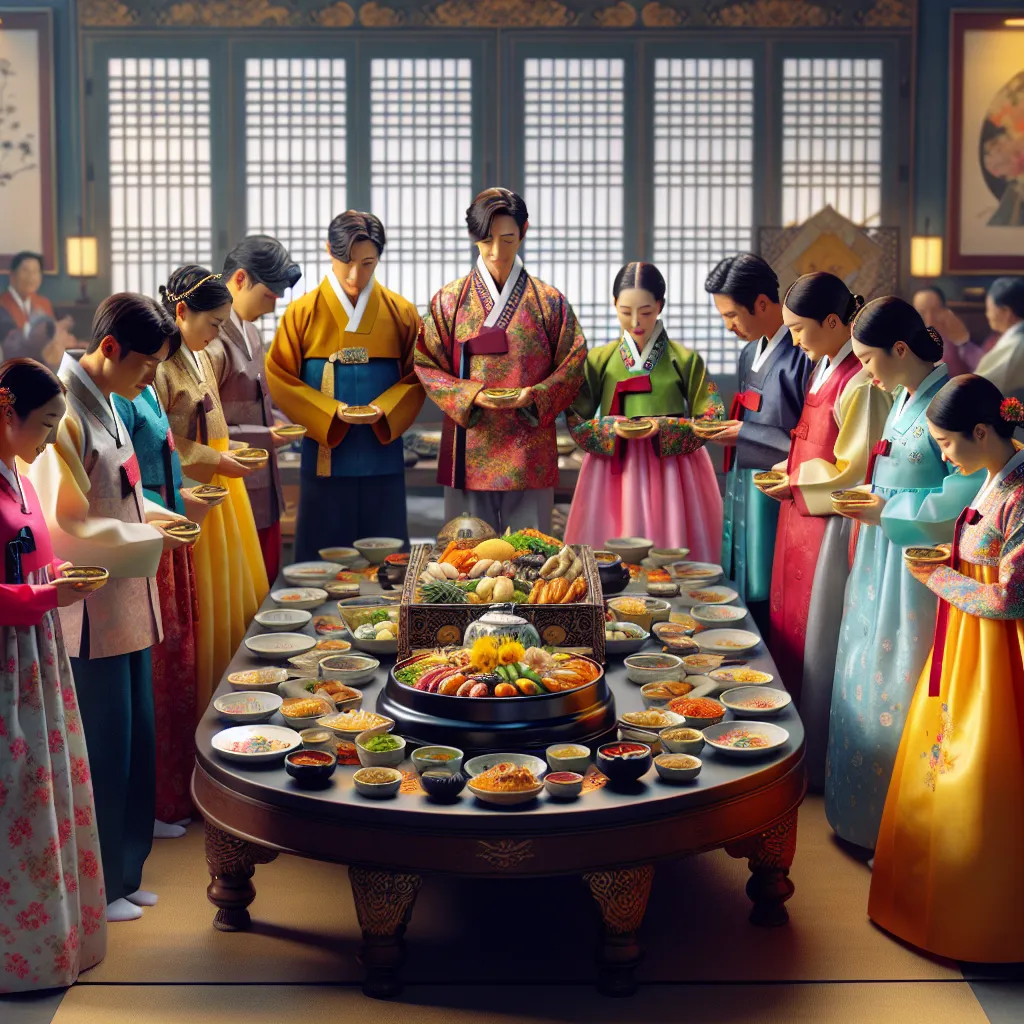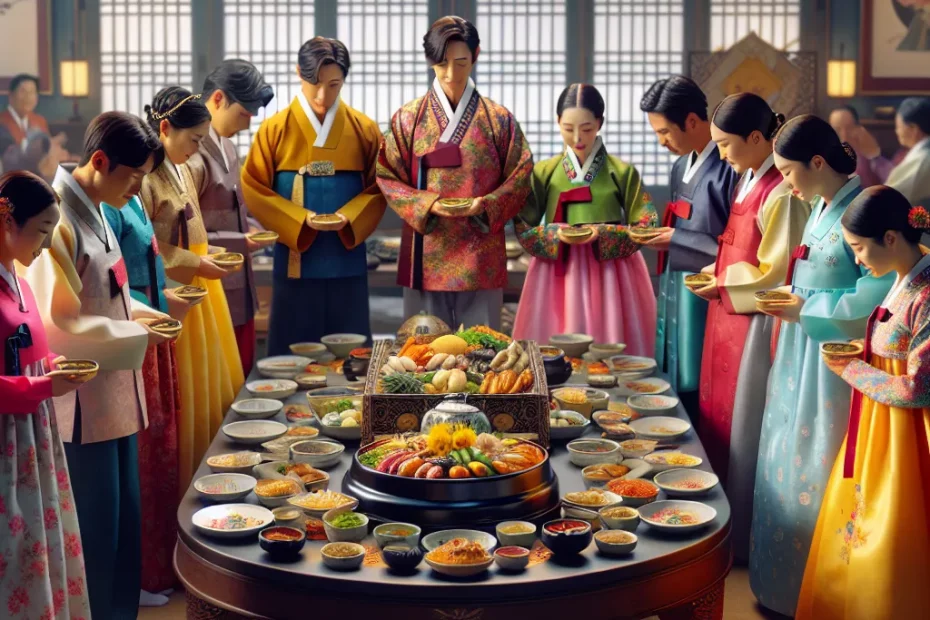As we approach the festive season, families around Korea are gearing up to celebrate Chuseok, a time-honored tradition that brings loved ones together in joyous celebration. This important holiday holds a special place in Korean culture, reflecting the values of gratitude, family, and tradition. Chuseok is not just a time for feasting on delicious traditional foods, but also for honoring ancestors and participating in cultural activities that have been passed down through generations. It is a time to reflect on the past, cherish the present, and look forward to the future with hope and unity. Let us delve into the rich tapestry of Chuseok traditions and customs, exploring the essence of this meaningful holiday that continues to resonate with Koreans across the globe.

The Origin of Chuseok Tradition
Chuseok, also known as Korean Thanksgiving, is a significant and traditional holiday celebrated in Korea. The origin of Chuseok dates back to ancient times, rooted in the agricultural society of Korea. This harvest festival is a time for giving thanks for the year’s harvest and honoring one’s ancestors.
The History of Chuseok
The history of Chuseok can be traced back to the Three Kingdoms period in Korea, when the practice of offering the first fruits of the harvest to the spirits of ancestors began. This ritual was believed to bring blessings and prosperity to the community. Over time, Chuseok evolved into a major holiday where families gather to pay respects to their ancestors, share a bountiful feast, and engage in traditional activities.
Traditional Food and Unity
One of the key traditions of Chuseok is the preparation and sharing of delicious food. Songpyeon, a type of rice cake filled with sweet ingredients like sesame seeds and honey, is a staple Chuseok dish. Families come together to make songpyeon, bonding over the process of shaping and steaming the rice cakes. This culinary tradition symbolizes unity and harmony among family members.
Ancestral Ritual of Charye
Another important aspect of Chuseok is the ancestral ritual known as Charye. During Charye, families set up an elaborate table with various offerings such as fruits, rice cakes, and liquor to honor their ancestors. This solemn ceremony is a way to express gratitude for the sacrifices made by previous generations and to seek their blessings for the future.
Folk Games and Joyful Celebrations
In addition to ancestral rites, Chuseok also features folk games and activities that bring joy and laughter to the holiday. Ganggangsullae, a traditional circle dance performed under the bright full moon, is a highlight of Chuseok celebrations. This lively dance symbolizes unity and prosperity for the community.
Overall, Chuseok is a time-honored tradition that highlights the importance of family, gratitude, and cultural heritage in Korean society. By preserving and passing down these customs from generation to generation, Koreans continue to cherish the spirit of Chuseok and the values it represents.
Family Reunions and Celebrations
As we approach the time of Chuseok, also known as Korean Thanksgiving, families across South Korea are gearing up to come together for a time-honored tradition of reunion and celebration. This special holiday holds great significance in Korean culture, emphasizing the importance of family ties, ancestral respect, and gratitude for the harvest season. 🌾🍂
The Gathering of Generations
During Chuseok, which typically falls in September or October, families travel far and wide to reunite with their loved ones. It is a time when generations gather under one roof, sharing stories, laughter, and, of course, delicious traditional foods. 🍲🥢 The festive atmosphere is palpable as homes are adorned with vibrant decorations, and the air is filled with the sounds of joy and merriment.
Remembering Ancestors
One of the central aspects of Chuseok is the memorial services, where families pay tribute to their ancestors through rituals and offerings. This act of remembrance is deeply rooted in Confucian principles, highlighting the importance of honoring one’s heritage and expressing gratitude for the sacrifices made by previous generations. 🙏🏼💖
Preserving Tradition
Traditional customs such as the preparation of special dishes like songpyeon (rice cakes) and hanbok (traditional clothing) add a touch of nostalgia and authenticity to the celebrations. The meticulous care and attention to detail put into these preparations reflect the deep respect and love that Koreans have for their cultural heritage. 🎎🍡
Strengthening Bonds
As the holiday draws near, markets bustle with activity as families shop for gifts and delicacies to share with their relatives. The exchange of presents symbolizes goodwill and strengthens the bonds between family members, fostering a sense of unity and togetherness. 🎁👨👩👧👦
In essence, Chuseok is a time for reflection, gratitude, and connection. It serves as a reminder of the values that bind us together as a community and the importance of cherishing our roots. So, as families gather around the table to partake in a bountiful feast and exchange heartfelt conversations, the true spirit of Chuseok shines through – a celebration of love, family, and tradition that transcends time and space. ✨🌟
In conclusion, Chuseok is not just a holiday; it is a testament to the enduring power of family bonds and the richness of Korean cultural heritage. So, as we come together to honor our ancestors and create new memories with our loved ones, let us embrace the spirit of Chuseok with open hearts and grateful spirits. Happy Chuseok to all! 🌕🌸
Traditional Chuseok Foods
Songpyeon (송편)
Songpyeon is a must-have Chuseok delicacy, made of rice cake dough stuffed with sweet fillings such as sesame seeds, red beans, or chestnuts. These little rice cakes are shaped into half-moon shapes and steamed on a bed of pine needles, giving them a unique flavor and aroma.
Japchae (잡채)
Japchae is a colorful and flavorful dish made of glass noodles stir-fried with an assortment of vegetables such as carrots, spinach, and mushrooms. The dish is seasoned with soy sauce and sesame oil, creating a harmonious blend of textures and flavors.
Jeon (전)
Jeon refers to a variety of Korean pancakes that are commonly enjoyed during Chuseok. These pancakes can be made with a wide range of ingredients, including vegetables, seafood, and meat, all coated in a light batter and pan-fried to crispy perfection.
Tteokguk (떡국)
Tteokguk is a traditional rice cake soup that is often served on Chuseok to symbolize good luck and prosperity for the coming year. The round shape of the rice cakes represents the wish for a smooth and successful year ahead, making it a staple dish during this festive time.
Sikhye (식혜)
Sikhye is a traditional sweet rice drink that is enjoyed as a dessert. Made from malted barley and cooked rice, this refreshing beverage is known for its soothing and slightly fizzy taste, making it a perfect way to end the celebratory meal.
Chuseok is a time for families to come together, express gratitude, and enjoy the bountiful harvest through these traditional foods. Each dish carries a rich history and cultural significance, adding depth and meaning to the festivities. As Koreans gather around the table to share these delectable dishes, they not only savor the flavors but also cherish the bonds of family and tradition that make Chuseok a truly special time of the year. 🌕🍚🎉
Cultural Activities and Customs
Chuseok, also known as Korean Thanksgiving, is a time-honored tradition celebrated with great enthusiasm and reverence in South Korea. This annual harvest festival, which typically falls on the 15th day of the 8th month of the lunar calendar, holds significant cultural importance for Koreans around the world. During this festive period, families come together to pay respects to their ancestors, share delicious food, and engage in various traditional activities that have been passed down through generations.
The Tradition of Charye
One of the most iconic customs of Chuseok is the preparation and sharing of a special feast known as “Charye.” This elaborate ritual involves setting up an ancestral memorial table with an array of dishes including songpyeon (rice cakes), japchae (stir-fried glass noodles), and bulgogi (marinated beef). The meticulous arrangement of food on the table symbolizes gratitude towards ancestors and a wish for prosperity in the coming year. Family members gather around the table to offer deep bows as a sign of respect before enjoying the meal together.
The Practice of Seongmyo
Another cherished tradition during Chuseok is the practice of Seongmyo, or ancestral rites. Families visit ancestral gravesites to clean and maintain the burial mounds, offering food, drinks, and burning incense as a way to honor their deceased relatives. This solemn ritual is a time for reflection and remembrance, strengthening the bond between past and present generations.
In addition to these customs, Chuseok is a time for various cultural activities that showcase the rich heritage of Korea. Folk games such as ssireum (traditional wrestling) and Ganggangsullae (circle dance) are popular during this festive period, bringing communities together in joyous celebration. Hanbok, the traditional Korean attire, is often worn during Chuseok to pay homage to the country’s cultural roots and add a touch of elegance to the festivities.
As the autumn moon shines brightly in the night sky, families gather outdoors to appreciate the beauty of the full moon, a symbol of unity and abundance. The tradition of Ganggangsullae, where participants form a circle and dance under the moonlight, is a mesmerizing sight that captures the essence of Chuseok celebrations. This communal dance not only fosters a sense of togetherness but also serves as a form of prayer for a bountiful harvest and good fortune.
In conclusion, Chuseok is a time of joy, gratitude, and reverence for Korean families as they come together to honor their heritage and create lasting memories. Through traditional customs, cultural activities, and heartfelt gatherings, this harvest festival embodies the spirit of unity and thanksgiving that has been cherished for centuries. Let us embrace the traditions of Chuseok with open hearts and minds, celebrating the beauty of Korean culture and the enduring legacy of family bonds. 🌕🍂🎉
As we celebrate Chuseok, the Korean Thanksgiving, it is a time to reflect on the importance of family, tradition, and cultural heritage. This annual holiday brings families together, fostering a sense of unity and togetherness. Through traditional foods, cultural activities, and customs, Chuseok provides a unique opportunity to honor the past and create lasting memories for the future. The significance of this holiday extends beyond just a simple gathering; it is a time to express gratitude, respect ancestors, and strengthen bonds with loved ones. Chuseok serves as a reminder of the values that have been passed down through generations, highlighting the rich tapestry of Korean culture. Embracing these traditions not only connects us to our roots but also shapes our identity and sense of belonging. In a fast-paced world, Chuseok offers a moment of pause, reflection, and appreciation for the blessings in our lives. Let us cherish this time-honored celebration and continue to pass on its legacy for generations to come.
